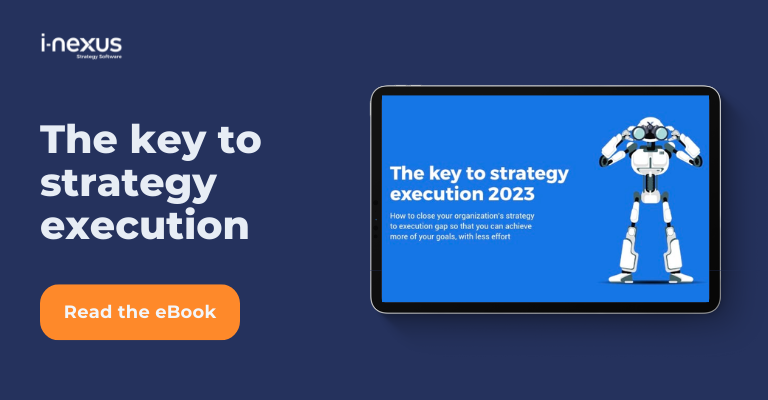Account for your strategic risks, opportunities, threats, and assumptions with scenario planning - the only plan you can rely on for the future. Find out what it all means with our ultimate guide.
In times of change, there is only one constant - change. To prepare for uncertainty, planning for the future is more important than ever. One way to do that is through scenario planning. By imagining and preparing for possible tomorrows, your business can stay agile and adapt quickly to changing circumstances.
But what exactly is scenario planning? And why is it so crucial for businesses?
This guide explores everything you need to know about scenario planning. From understanding what it is and why it matters, to examining real-life case studies of companies that didn't prepare effectively.
We'll also delve into the different types of scenario planning and common techniques, as well as offer step-by-step instructions on how to scenario plan effectively.
Plus, we'll share best practices, benefits, and challenges of scenario planning so you can implement this powerful process in your business. Whether new to scenario planning or looking to improve your current practices, this is the definitive guide to scenario planning.
Jump to the section you want
Read on or click below to jump to the part of scenario planning you want to learn about:
- What is scenario planning?
- Why is scenario planning important?
- Scenario planning case study: Blockbuster
- Scenario planning case study: Fukushima
- What are the different types of scenario planning?
- What are the common scenario planning techniques?
- How do you scenario plan?
- What are some best practices of scenario planning?
- What are the benefits of scenario planning?
- What are the challenges of scenario planning?
- Scenario planning articles and books to read
What is scenario planning?
Scenario planning is a strategic planning technique businesses use to prepare for multiple potential future events. It involves analyzing a range of possible future situations a business could face and creating plans to respond to each using the resource and internal skills available.
Scenario planning helps businesses to be more prepared for the future by identifying potential risks and opportunities and creating contingency plans to address them.
By considering a range of scenarios, businesses can develop a more comprehensive and robust strategy that considers various possible outcomes.
The scenario planning process typically involves identifying key trends and drivers that could impact the business, developing multiple scenarios based on those trends and drivers, and then evaluating each scenario to determine its potential impact on the business.
The business can then use this information to develop strategic plans and make informed decisions about allocating resources and managing risks.
But worryingly, it would seem that leaders aren't confident in achieving their strategic goals regardless of the scenario.
"Only 2% of leaders are confident that they will achieve 80–100% of their strategic objectives"
Bridges Business Consulting
Why is scenario planning important?
So, why does your business need to scenario plan? There are plenty of reasons, but here are some to keep in mind:
-
Uncertainty
It allows you to prepare for multiple potential future scenarios, especially in times of uncertainty, which helps them to make better decisions and respond more effectively to unexpected events. -
Risk management
It helps you to identify and manage risks by developing contingency plans for each scenario, which can reduce the impact of harmful events on the business. -
Innovation
It encourages you to think creatively and consider new opportunities you probably wouldn't have considered. Lateral thinking is a lost art. -
Competitive advantage
It enables you to stay ahead of your competitors by anticipating and responding to changes in your market and adapting strategies accordingly.
Case study: Blockbuster and Netflix
An example you're likely aware of, but pays to reiterate, is Blockbuster.
In the early 2000s, Blockbuster was the dominant player in the video rental industry. When Friday evening rolled around, Blockbuster was the perfect side to a main of Chick Fil-A or Pizza Hut, until it wasn't.
While Chick Fil-A and Pizza Hut adapted towards digital business when their markets drastically shifted, Blockbuster did not with theirs.
Blockbuster didn't anticipate the impact streaming services like Netflix would have on the market. While Netflix started off with DVDs of movies, they soon anticipated a shift in the market.
Blockbuster's management team did not consider the possibility that people would prefer to stream movies rather than rent physical copies from stores. That oversight was costly - fatal, in fact.
As a result, the company was slow to adapt to the changing market and filed for bankruptcy in 2010.
In contrast, Netflix had already started investing in streaming technology and quickly gained a competitive advantage, eventually becoming the market leader in video streaming.

From 6,000 stores in 2005 to 1,500 in 2012, and 54 in 2014, in 2023, only one Oregon store remains. Their downfall was harsh, but there is hope for those after their nostalgia hit...
Case study: manufacturing fallout in Japan
The Fukushima disaster in Japan in 2011 significantly impacted the global manufacturing industry.
One company that was hit hard was Renesas Electronics, a Japanese semiconductor manufacturer. Renesas Electronics supplied microcontrollers for automotive companies, including Toyota, Honda, and Nissan.
The disaster resulted in the shutdown of the Fukushima Daiichi nuclear power plant, which led to power shortages and disruptions to the supply chain. Renesas Electronics relied on the plant for its energy supply, and as a result, the company was forced to shut down its factories.
Renesas Electronics had not planned for such a scenario and did not have a contingency plan, much to the harm of its core business.
The shutdown of the factories resulted in a significant loss of production, and the company could not fulfill its orders. This created a ripple effect on the automotive industry, with Toyota, Honda, and Nissan all experiencing production delays.
The impact of the disaster on Renesas Electronics was significant. The company's market share in the automotive microcontroller market dropped from 40% to 30%, and it reported a net loss of $2.9 billion in the fiscal year ending in March 2012.
Renesas Electronics' failure to plan for the scenario resulted in significant losses and damage to the company's reputation. While changes were made, further natural disasters have posed a risk to their production, such as a 2022 earthquake.
What are the different types of scenario planning?
There are several types of scenario planning that businesses can use, including:
Basic scenario planning
This type of scenario planning involves creating two or three potential scenarios representing the most likely outcomes. These scenarios are then used to develop strategic plans that can be implemented in the event that any of the scenarios occur.
Worst-case scenario planning
This type of scenario planning involves creating a scenario representing the worst possible outcome for the business. This scenario is then used to identify potential risks and develop contingency plans to minimize the impact of the worst-case scenario.
Black swan scenario planning
This type of scenario planning involves creating a scenario representing a rare and unpredictable event that would significantly impact the business. This scenario explores potential risks and develops contingency plans to implement when such an event occurs.
Reverse scenario planning
This type of scenario planning involves identifying a desired outcome and then working backward to identify the steps needed to achieve that outcome.
This approach can help businesses identify potential roadblocks and develop contingency plans to overcome them.
Quantitative scenario planning
This type of scenario planning involves using data and mathematical models to create and analyze potential scenarios. This approach can help businesses identify trends and patterns and develop more accurate predictions of future events.
What are the common scenario planning techniques?
So, with those types of planning in mind, what sort of tools are available to you in your exercise?
Trend analysis
A trend analysis involves identifying and analyzing historical data to identify patterns and trends that can be used to make predictions.
Delphi method
The Delphi method is a technique that involves gathering input from a group of experts on a particular topic. The experts provide their opinions anonymously, and the results are compiled and analyzed to identify potential scenarios.
Cross-impact analysis
A cross-impact analysis is a technique that involves identifying the relationships between different factors and events that could impact your business. This technique can help you identify a particular scenario's potential secondary effects.
Environmental scanning
Environmental scanning involves gathering and analyzing information about the external environment in which you operate. This information can be used to identify potential trends and developments that could impact the business.
Scenario writing
Scenario writing involves creating detailed narratives that describe potential future events and their impact on the business. These narratives can be used to explore potential scenarios and develop contingency plans.
Backcasting
Backcasting involves identifying a desired outcome and then working backward to identify the steps needed to achieve that outcome. This approach can help you to spot roadblocks and develop contingency plans to overcome them.
Scenario planning tools
Scenario planning comes with a fairly standard set of tools. Here's what you need to know about them:
SWOT analysis
SWOT analysis is a technique used to identify the Strengths, Weaknesses, Opportunities, and Threats of a business.
A SWOT can be used to assess the current state of the business and identify potential future scenarios.
By analyzing the strengths and weaknesses of the business, you can identify potential opportunities and threats that may impact the business in the future.
PEST analysis
PEST analysis is a tool used to identify the Political, Economic, Social, and Technological (also see PESTLE) factors that could impact the business.
It can be used to identify potential trends and drivers of change that could impact the business.
Understanding these factors allows you to develop scenarios that consider potential future market changes.
Porter's five forces analysis
Porter's five forces analysis is a framework used to analyze the competitive environment of a business.
It considers five key factors:
1. The threat of new entrants
2. The bargaining power of suppliers
3. The bargaining power of buyers
4. The threat of substitutes, and
5. The intensity of competitive rivalry.
By understanding these factors, you can develop scenarios that consider potential changes in the competitive environment.
Decision tree analysis
Decision tree analysis is a tool used to model potential future outcomes and their associated probabilities.
It involves creating a tree diagram that represents the possible outcomes of a decision and its likelihood.
By using decision tree analysis, you can evaluate the potential outcomes of different decisions and develop contingency plans based on the probabilities of each outcome.
Monte Carlo simulation
Monte Carlo simulation is a technique to model the probability of different outcomes in a complex system.
It involves using random sampling to generate possible outcomes and their associated probabilities.
By using Monte Carlo simulation, you can evaluate the potential outcomes of different scenarios and develop contingency plans based on the probabilities of each outcome.
How do you scenario plan?
Many options are available when it comes to the actual "doing" of scenario planning. For the purpose of simplicity and to avoid this exercise being one of "pie in the sky / blue sky thinking," a more practical approach should be embraced.
But before that happens, consider having subject matter experts, operational, and front-line staff involved in the process. Their insights and experience are invaluable and serve as a great way to engage the organization in the efforts and reinforce just how important this exercise is.
With that in mind, let's explore the process you can use to be dynamic in every event:
1) Define the scope and purpose of the scenario planning exercise
It's important to define the scope and purpose of the scenario planning exercise. This involves identifying the business problem you are trying to solve and the specific goals you want to achieve.
2) Identify the key drivers of change
The next step is to identify the key drivers of change that could impact the business.
These drivers could include trends in the market, changes in consumer behavior, technological advancements, and regulatory changes.
It's important to identify a broad range of drivers to ensure that you consider a wide range of potential scenarios.
3) Develop potential scenarios
Using the key drivers identified in Step 2, develop a range of potential scenarios that could impact the business.
It's important to consider both positive and negative scenarios and various outcomes.
4) Assess the impact of each scenario
Once you have developed a range of potential scenarios, assess the potential impact of each scenario on the business.
This could involve conducting a SWOT analysis or other relevant analysis to identify each scenario's strengths, weaknesses, opportunities, and threats.
5) Develop contingency plans for each scenario
Develop contingency plans for each scenario based on the potential impact of each scenario.
These plans should identify the actions the business would need to take in response to each scenario to mitigate risk and take advantage of potential opportunities.
6) Monitor and update the scenarios
Scenario planning is an ongoing process, and it's important to monitor the key drivers of change and update the scenarios on a regular basis.
This ensures that the business is well-prepared for potential future scenarios that could impact the business.
7) Execute the plan
The scenario planning exercise is worthless without executing this plan. That requires having sound strategy execution management based on standardized processes, a PMO (or PgMO), and giving your team the tools they need to deliver.
What are some best practices of scenario planning?
-
Involve a cross-functional team in the process
Scenario planning requires input from a variety of perspectives and expertise.Assemble a diverse team from across different functions and levels of the organization to ensure that all relevant factors are considered.
And as an added bonus, this'll also help to promote buy-in and engagement from all stakeholders.
-
Use a range of scenarios, including best-case, worst-case, and moderate-case scenarios
Develop scenarios that cover a range of potential outcomes, from the most optimistic to the most pessimistic.This will help ensure that the organization is prepared for various possible futures.
-
Use data and insights to inform scenario development
Develop scenarios based on both internal and external data and insights.Use data analytics, market research, and other sources of information to identify key drivers and trends that could impact the organization's future.
-
Monitor and update scenarios regularly to reflect changing market conditions
Your environment is constantly evolving, so too must your scenarios.These need to reflect changes in the market or other external factors.
Set up a process for monitoring and updating scenarios, and schedule regular reviews to ensure that scenarios remain relevant and up-to-date.
-
Test scenarios to identify potential gaps and opportunities
Once scenarios have been developed, test them to identify potential gaps in the organization's preparedness or opportunities for growth.Use simulations or other tools to stress-test the organization's response to different scenarios and identify areas for improvement.
What are the benefits of scenario planning?
Conducting scenario planning as part of your business' architecture has several benefits. Here's what to focus:
-
Better preparedness
Scenario planning helps you to be better prepared for unexpected events by considering a range of possible future scenarios.Those organizations that can identify and mitigate potential threats are those likely to capitalize on emerging trends and seize opportunities.
-
More strategic decision-making
By using scenario planning to develop a range of potential futures, organizations can make more informed and strategic decisions.Scenarios can help leaders identify the most likely outcomes and develop plans to respond accordingly.
-
Improved agility and flexibility
Scenario planning can help increase your organizational agility, ensuring you're flexible in response to changing market conditions.By better understanding potential future scenarios, you'll develop contingency plans and respond quickly to unexpected events.
-
Increased innovation
Scenario planning encourages leadership to think creatively and develop innovative solutions to potential challenges.By considering a range of possible futures, you'll be well-placed to identify new opportunities for growth and development.
-
Better communication and collaboration
Scenario planning involves input from various organizational stakeholders and functions, promoting better communication and collaboration.Scenario planning encourages cross-functional teams to collaborate to develop a shared understanding of potential risks and opportunities and develop strategies aligned with your strategic goals and objectives.
-
Improved risk management
You'll minimize losses and avoid potential crises by identifying and mitigating potential risks.Organizations can develop strategies tailored to different risk levels and potential outcomes by considering various scenarios.
-
Increased resilience
Scenario planning can help organizations to build greater resilience to unexpected events.Organizations can adapt quickly to unexpected events, minimize disruption, and recover quickly by developing contingency plans and preparing for a range of potential scenarios.
What are the challenges of scenario planning?
While scenario planning brings plenty of benefits, there are challenges. Here's what you need to know:
-
Time and resource constraints
Scenario planning can be time-consuming and resource-intensive, particularly if an organization conducts it for the first time.You may struggle to allocate the necessary time and resources to the process, particularly if facing other urgent business priorities.
-
Difficulty in selecting the right scenarios
Developing relevant and plausible scenarios can be a complex and challenging process.You may struggle to identify the most relevant and impactful scenarios or agree on their scope and focus.
-
Data limitations
Scenario planning requires access to relevant and reliable data to inform scenario development and analysis.You may struggle to access the necessary data or find the available data incomplete or unreliable.
-
Resistance to change
Scenario planning can be a disruptive process that requires changes to existing strategies, processes, and structures.Some stakeholders may resist change, particularly if it requires significant shifts in their roles or responsibilities.
-
Difficulty in operationalizing scenarios
Once scenarios have been developed, organizations may struggle to operationalize them and develop specific action plans to respond to different scenarios.This can be particularly challenging if scenarios are complex or uncertain or require significant changes to existing processes or structures.
-
Maintaining the relevance of scenarios
Scenario planning requires ongoing monitoring and updates to ensure the scenarios remain relevant and up-to-date.Organizations may struggle to maintain the relevance of scenarios over time, particularly if facing rapidly changing market conditions or other external factors.
Scenario planning books and articles you should read
Many books are available on scenario planning, and while what you dip into depends on your taste, these are some popular books you'll find helpful:
"Scenario Planning: A Field Guide to the Future" by Woody Wade
This book provides a practical and accessible guide to scenario planning, focusing on applying it in a business context.
It includes case studies and examples from various industries and covers scenario development, implementation, and monitoring.
"The Art of the Long View" by Peter Schwartz
This classic book on scenario planning provides a detailed overview of the process, including how to develop and use scenarios to inform strategy and decision-making.
The book includes examples from various industries and contexts and provides practical guidance on applying scenario planning in practice.
"Scenario Planning: Managing for the Future" by Gill Ringland
This book provides a comprehensive overview of scenario planning, focusing on using it to manage risk and uncertainty.
It includes case studies and examples from various industries and covers scenario development, implementation, and evaluation topics.
"Scenario Planning: The Basics" - Harvard Business Review
This article briefly introduces scenario planning, including why it is important and how it can inform strategy and decision-making.
It includes examples from various industries and contexts and provides practical guidance on how to get started with scenario planning.
"Scenario Planning: Gaining Perspective and Mitigating Risk" - EY
This briefly overviews scenario planning, including how it can manage risk and uncertainty.
It includes examples from various industries and contexts and provides practical guidance on applying scenario planning in practice.
How i-nexus can help you with your scenario planning
Introducing, spreading, or standardizing your approach to scenario planning can be challenging.
There are many competing interests, and the problems often start with no central system to plan and track your scenarios.
To see how i-nexus solutions can help you with your scenario planning, visit our solutions page today.
Learn more about strategy execution
Take the next steps in your journey by exploring our strategy execution resource hub.
About the author
James Milsom is Head of Marketing at i-nexus.
As Head of Marketing, his drive is to raise awareness and understanding of enterprises' challenges in delivering strategic goals amidst changing markets and the obstacles traditional tools and methods present leaders.
If you’d like to discuss strategy, contact James at james.milsom@i-nexus.com or connect with him on LinkedIn for the latest insights.




